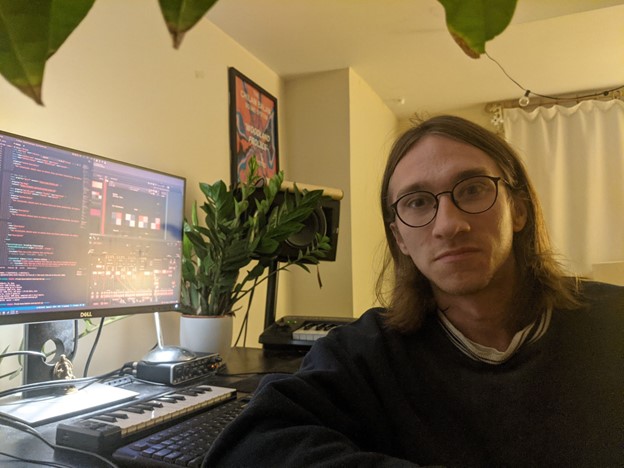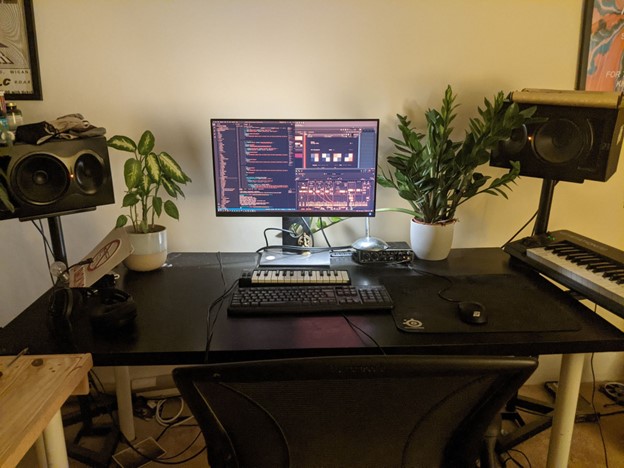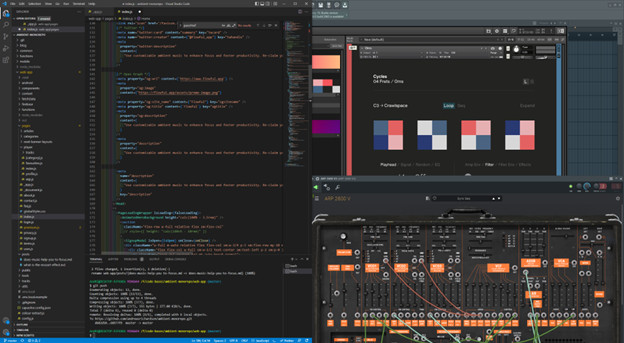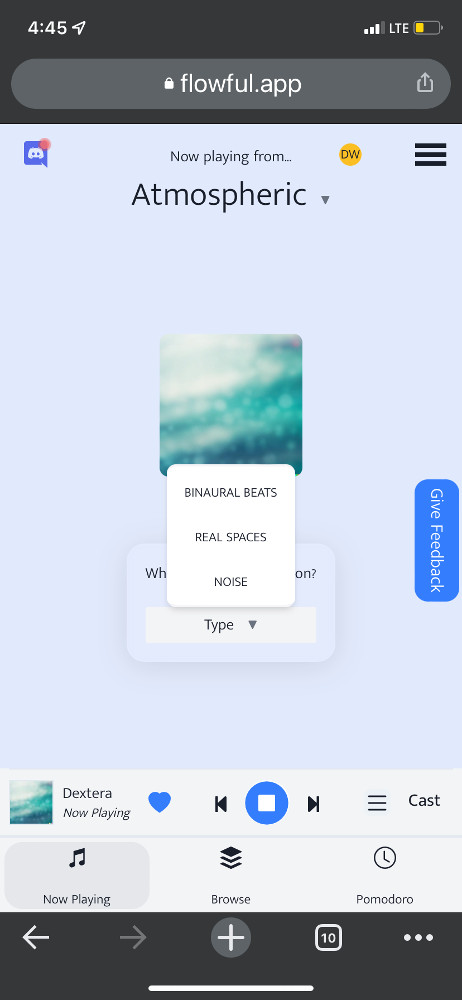Ambient Music, AI, and Ambition: How to Start an Audio Business
Is all ambient music equal? Maybe it’s not in execution, but it is in intent.
A purposeful peace radiates from all kinds of ambient music, with countless interpretations. From ancient instruments to modern day masters, ambient sounds induce improved focus, concentration, and connection to the moment.
Whether you’re listening in a yoga pose, working intently, drifting to sleep, or transcendentally meditating, ambient sound shifts you. The longer you listen, the more deeply it weaves into your biorhythms, empowering whatever’s at hand.
Ambient sound is beautifully unobtrusive, with tone and atmosphere taking precedence over rhythm or traditional structure. People can listen to their contemplative textures passively or actively. Sound sources can be anything from waveform generators to waterfalls.
Macro trends are creating a wider interest in ambient music and sound. For example, recent projections are that 25% of all professional jobs will be remote by year’s end 2022. Many home-based workers rely on ambient sound apps to create atmosphere, dialing up everything from a café in the rain to Marconi Union’s 10 hour-long “Weightless”, to nature sounds and much more.
Flowful is one example of how to build a business from ambient music. Founded by computer scientist Drew Richardson, it uses procedurally generated ambient music to enable flow states. Offering both a free and premium tier, Flowful launched with a profit model and is quickly growing its following.
Appling a thoughtful balance of musical arrangement and AI, Richardson composes and codes from his U.K. studio. See his perspective on how ambient music makes you better, and how he consistently “ships” to stay on schedule.
Flowful allows him to blur the line between music and software, sampling real instruments and then coding all heck out of them. The result is a gently effective offering of Classical, Atmospheric, and Polyrhythmic categories. New titles are regularly introduced, and listeners can tweak the app (on mobile or desktop browser) to provide light beats, real spaces, pink/white noise, and even a pomodoro time management tool.
Read on to see how his audio business plan was born and unfolded (hint: solving a need). He’ll explain what makes Flowful a different way to discover ambient music, and how he knew he was on to something from Day One.
Tell us your “elevator pitch” for Flowful – how do you explain it to someone for the first time?
Flowful is a website which provides uninterrupted ambient music. Each track is generated for you in real-time which means no annoying ads, no breaks in between songs and crazy recommendations when a song finishes.
It’s designed so that you press “play” once, and don’t have to think about it again, which means it’s great for when you’re trying to focus. Its main aim is to help people achieve flow state, and do their best work, for as long as possible!
The Website calls it “procedurally generated ambient music”. What does it mean to be procedurally generated? How is that different from other types of ambient music?
A “regular” ambient music track – the same as any genre – is fixed length, usually around 4 minutes. In the case of ambient soundscapes, they can often be two minutes or less.
Flowful tracks are different in that they are generated in real time, which means they never end. They vary themselves over time and are unique each time you press “play.” The algorithms I’ve coded builds the track as you are listening to it.
What made you interested in ambient music as a listener? How do you use it in your personal life?
I’m pretty much always listening to music, which means when it comes down to music for focusing, I’m really picky.
If things are too interesting, the music side of my brain will focus in on that instead, and I’ll wonder how a synth was made, or think about what’s going to come next in the song or something. Even things like drum patterns are often too much for me. So ambient became my go-to choice while coding and working, as I’m sure it does for many people.
Why does ambient music help with concentration for people in general?
There’s a few reasons, but the main one for me is it blocks an avenue in which you might become distracted. Everyone has what’s called “unconscious attention” and distracting sounds or songs are a major way that this unconscious attention takes over and replaces your conscious attention, which is what happens when you lose focus on something. Ambient music can work to fill that void and block out that attack vector for potential distractions, which can help you stay on task.
Another reason is you’re just more likely to be motivated to work on something if you’re listening to some music you like!
Music & AI
You wrote your university Computer Science thesis on using AI to generate music. How did this inform your approach to the Flowful music engine?
So I actually came away from that deciding to really cut back on the amount of AI I was going to use. It turned out at the time to create things which I didn’t like the sound of – a lot of classical-sounding piano riffs. While this is good, it doesn’t really lend itself to infinite generation.
I figured it’s much easier and I have more control over it if I just program these algorithms myself, and feed in snippets from AI when I need them. I did keep one algorithm from that project, though, which decides how similar a segment of music is to the upcoming segment, and discards it if it’s too dissimilar. This helps to keep the music sounding cohesive.
What are the audio tools such as AI engine, DAW and plugins, plus instruments that you use to produce these ambient music pieces?
In the browser, the audio library which plays the samples is called Tone.js. Google’s Magenta library handles the AI stuff. Then I write my own code to vary and keep the track running.
All the samples for each song are recorded by VSTs that I own. A lot are from an Arturia classics pack – the ARP2600 is my favorite – and I use FL Studio and Audacity to render and work with the samples.
SoundToys EffectRack also features heavily in the music – I use pretty much all the plugins in there. No hardware stuff unfortunately – everything is in the box!
Code vs. Music
You said that “There’s always a battle between the rigidity of writing code and the fluidity of writing music.” How do you strike a balance between the two when you’re writing a new piece?
I’ve figured out a workflow where I can work on both parts separately, which helps untangle things somewhat.
I make a 5-6 minute version of what will become the track in my DAW, then convert that to code whenever I’m ready. When I’m feeling creative or inspired, I’ll sit in the studio and produce music as if it wasn’t going to be a part of Flowful.
Then when I want to be productive, but don’t have any ideas, I can use that time to “convert” the track into code, and figure out ways to vary it over an infinite length of time.
This can actually have interesting side effects though when I accidentally write bugs into the code, and I prefer the track with the bugs! Sometimes the mistakes just sound better than how I intended. This has happened a few times, with one of the most recent tracks, “Dextera”, included.
How do you know when a new composition is “good” and ready for the site, as opposed to needing more tweaking?
This is probably one of the hardest things about maintaining the site. As I’m sure a lot of people are, I’m almost never happy or ready to release my own work. Having this as a software project forces me to release these things, so I just have to go with it and set artificial deadlines for releases.
I think the fact that it’s a software product at the end of the day does actually help me to get the music out there. Software engineering is all about “shipping”, which means releasing features as fast as you can and getting them in front of the end user. It’s a good practice to take into music production to get over the fear of putting your stuff out there.
I give myself something else to work on and listen to the track for a good few hours before I give it the green light usually though.
Building Ambient Music Offerings
Tell us about Flowful’s music offerings. You have “Classical”, “Atmospheric”, and “Polyrhythmic” categories. How did you decide on these three?
I just tried to keep to how I would classify other focus music that I listen to. “Polyrhythmic” was the hardest as it’s probably the most unique and simple but the name just sort of describes how it’s made. If you have any better ideas for naming them – let me know, I’m all ears!
What differentiates these three categories, both musically and in terms of the type of work tasks they support? How can the listener choose between each one to maximize concentration?
People should choose based on enjoyment, that’s the most important factor when choosing some ambient music or sound to work to, other than not having any lyrics. You’ll get a nice boost of motivation if you enjoy the music that you have on in the background.
I have a separate section which allows you to add-in other background noises, such as cafe sounds or rain noises, which are more tailored to specific tasks, if that’s your thing.
You regularly add new titles to each category. How are you able to program them to be unique from each other? In other words, what parameters do you adjust to make “Rolling Deep” different from “Echo” in the Classical Category?
Each track is made from unique samples, which come from different instruments, so they should sound different off the bat. Then in terms of programming, I always work backwards from what I have in my DAW.
Each track hopefully should be different from the previously made track, so when it comes to programming it, it’s a case of replicating that layout, with an infinite structure. Structurally, I program things like filter automation, note selection and effects differently to keep things interesting.
How do you come up with the names of each title, and why is it important to get those right – how do they help guide the listener to the right piece for them when they need it?
I probably don’t put enough time in when selecting them honestly! I just go with what’s on my mind at the time, that best fits the sound of the track I’ve made.
Ambient Economics: Crafting the Business Plan
What made you believe that there was a market need for a dedicated source of ambient music?
Other platforms always have one major problem which I wanted to solve for: their recommendation algorithms. Sometimes they’re great, and sometimes they’re awful. I find it really annoying when I get ripped out of the zone by something distracting. So I figured I’d remove the algorithm, and make the music itself infinite, rather than the recommendations. Then build a business around that concept.
Ambient music seems to be more popular than ever. What with the boom that LoFi hip hop is having, along with ambient Spotify playlists, I figured there was more than enough room in the market.
How are you going about creating a profitable business around ambient music? As the project has unfolded, what are the different components you’ve realized you must offer besides the music itself?
The site was the first thing to come about. Then I’ve been trying to also create a community around it of people who like the music.
Probably the most difficult thing is getting the site in front of people. I haven’t taken any startup capital, which means running ads costs money that I don’t have. I’m having to rely on organic sources and ways to show people the music. It’s a learning curve for sure, and probably the best, and most satisfying, way this has worked so far is by word of mouth – people recommending Flowful to others.
How has user feedback further helped you shape Flowful?
As it’s a software product, users are the number one priority, so I try and involve them at any step I can. Sometimes people come back with things I’d never have thought of – for example, a ton of people have requested a Chromecast / Siri / Amazon Alexa app they can use on their smart devices.
As I don’t really use them, I’d never have built that if I hadn’t spoken to my users. But now it’s underway and should be released soon.
I tend to release songs without feedback, then if people have ideas, incorporate them into the next song as I don’t like to dwell on the same idea for too long. One thing people said was that they wanted some happier, less melancholy songs, so my recent output has tried to be a bit more uplifting.
What have been the surprises, both good and bad, along the way as you’ve built Flowful into a business?
On the day Flowful launched, it got a ton of traffic from Reddit and other forums. This gave me my first sales and, even though I was pretty convinced the project was worthwhile, it still surprised me to know there were people out there who valued my product enough to pay for it.
It’s also a lot of work, which shouldn’t surprise me, but sometimes does.
You said that the intersection of creative endeavors and AI is heating up now – why is this a growing market at this moment?
Some of the major AI players have just started bringing their work to a consumer market. You may have heard of something called DALL-E 2, which I actually use to make my track art, that has brought a ton of attention to the space with its incredible outputs. Other companies are following suit and it’s going to make for a really interesting few years.
There’s a ton of unexplored or undeveloped applications of AI in the music world. Anything from helping to perfect a mix/master, coming up with melodies or even creating new sounds will be completely changed by it. It’s hard to picture it, but the practices we all use now will seem incredibly different in just 10 years time.
Lastly, you said that you think it’s important for people to combine two skills into one project – for you, its producing music and software engineering. Why does this matter?
Well, I’m certainly no expert on this sort of thing but I think for one it makes you stand out more. There’s millions of Software Engineers and millions of Musicians in the world, and in either group I probably don’t excel, but if I combine the two, I have a better chance of carving out a unique niche.
I think this logic can be applied to almost any two or more different things that someone is good at. It also means you get to work on more stuff you like, which is always fun.
— David Weiss is an Editor for SonicScoop.com, and has been covering pro audio developments for over 20 years. He is also the co-author of the music industry’s leading textbook on synch licensing, “Music Supervision, 2nd Edition: The Complete Guide to Selecting Music for Movies, TV, Games & New Media.” Email: david@sonicscoop.com
Please note: When you buy products through links on this page, we may earn an affiliate commission.











[…] source […]